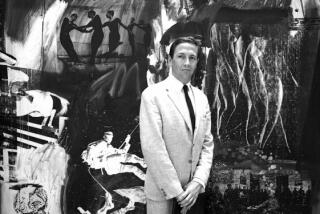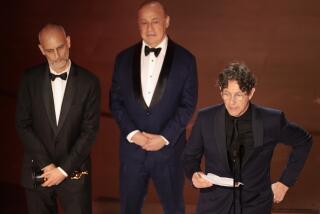Art Critics Face Up to a New World : Art: International group, meeting for first time in U.S., grapples with post-Cold War multicultural, political issues.
“Perhaps we spoke too soon,” New York critic Kim Levin cautioned her 200 colleagues as she opened the 25th Congress of the International Assn. of Art Critics, which was held during the weekend in Santa Monica.
The meeting’s theme, “Beyond Walls and Wars: Art and Politics in a Multicultural World,” was chosen in “that brief ecstatic interim between the toppling of the Berlin Wall and the burning of the Kuwaiti oil fields. None of us imagined that history would soon unfold the spectacle of a terrifying war in the Middle East, a brief retrograde coup in the U.S.S.R. or uncivil warfare in Yugoslavia,” Levin told delegates to the association’s first meeting in the United States.
“Perhaps, too, we bit off a bigger chunk of the issues than any mere gathering of art critics could comfortably chew,” Levin said. But chew they did--on politics, economics, censorship, ethnicity and the state of art in post-totalitarian societies. In full-day sessions, which will wind up today at the Santa Monica Public Library, an international array of critics spit out ideas seasoned with native experiences. Delegates from formerly communist countries in Eastern Europe met their counterparts from the West and stirred a pot of real-world issues affecting art.
Eastern Europeans appeared in record numbers, reporting that their newfound freedom has not created a utopia for artists and critics. Culture has lost state subsidies while the costs of printed matter and exhibition spaces have more than doubled, Czechoslovakia’s Petr Wittlich said.
“The mentality of artists in post-totalitarian countries is today rather complicated. . . . The totalitarian regime drove real artists into isolation and paradoxically developed their individualism. Today, these artists more than ever search for a common language, but it is up to them if they only repeat the words of the international artistic Esperanto or contribute something of their own to the international discourse,” Wittlich said.
Recalling a time when making an abstract painting was a political act and exhibitions of unofficial art had to fit in a single suitcase so that they could be packed up and shown clandestinely, Anda Rottenberg of Poland said her country had recently witnessed “a virtual explosion of expression in the visual arts.” Exhibitions that once had to be shown in the protective environment of churches are now in state museums. But, she lamented: “The only difference is that portraits of Lech Walesa have replaced those of communist leaders. . . . It’s a long way to the real democracy.”
The situation is equally confusing in Estonia, where taboos have fallen, but so has the National Gallery, Estonian critic Mart Kalm said.
Some Eastern European critics said the conference in far-off Los Angeles provided a rare chance to exchange ideas with their colleagues in neighboring countries, with whom they normally have little contact. Zelimir Koscevic, a Croatian--don’t call him a Yugoslav--used the meeting to spread the word about destruction of Croatian cultural monuments in the ongoing conflict.
“I would rather speak about art and war than art and politics,” he told the audience. He dutifully delivered his paper, but put most of his energy into distributing a videotape and statistics about damage to more than 200 Croatian museums, churches, libraries and historical sites--despite flags that mark them as cultural treasures.
Reports from less-beleaguered countries also reflected a turbulent scene. Canadian critic Gerald Needham said that multiculturalism had been so well accepted in Canada that a national policy was adopted in 1971 and a federal ministry was created, but the concept has come under lethal fire and the arts are currently “fighting for diminishing funds.”
Reports from the United States focused on obstacles to multiculturalism and battles over censorship and funds, but Rebecca Solnit of San Francisco dispelled some of the gloom in her talk, “Jesse Helms: Muse of the Nineties.” Artists and critics “owe a big debt of gratitude” to the conservative senator for “energizing” the art world. “He said that art is dangerous. That’s the most flattering thing that anyone has said in a decade,” she said, challenging artists and critics to continue engaging in “dangerous art.”
Critic David Hickey seconded Solnit’s notion and warned against a trend toward duplicitous criticism. Unlike artists, whose imagery can be protected by its inherent duplicity, critics are obliged to “insist upon the political relevance of art. Art will survive; criticism will not,” he said.
More to Read
The biggest entertainment stories
Get our big stories about Hollywood, film, television, music, arts, culture and more right in your inbox as soon as they publish.
You may occasionally receive promotional content from the Los Angeles Times.










